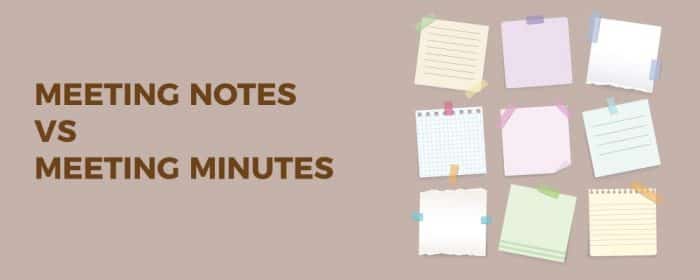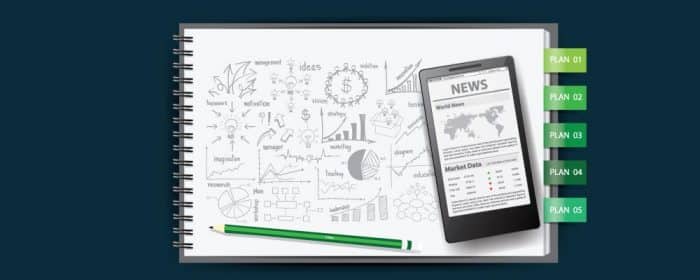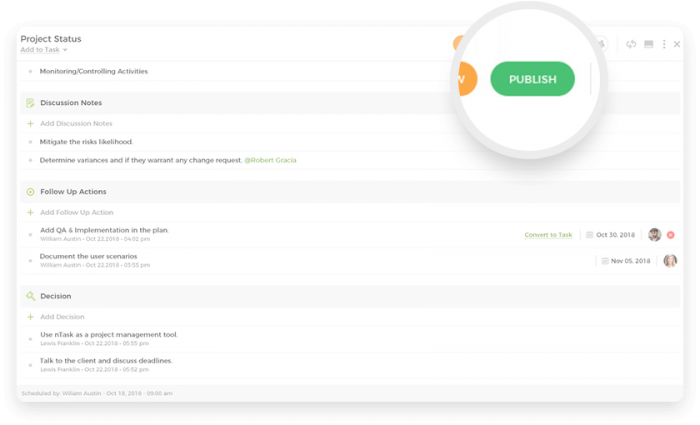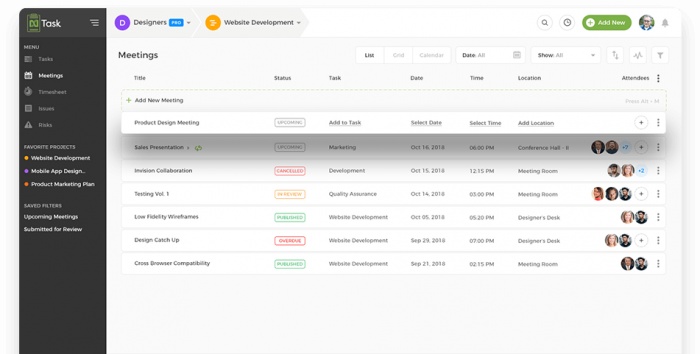Do you find it hard to compile and organize all the proceedings of a meeting? Worry no more, we have simplified the process to make it easier for you.
So, how to take meeting notes? Taking meeting notes is not really rocket science. It’s simpler than you think.
Taking meeting notes is more than just important as you wouldn’t want to draw a blank when your senior asks for specific information from the meeting.
This article is your how-to guide on how to take meeting notes efficiently. We’ll be outlining some pro tips to take your note-taking skills to the next level.
What, exactly, are meeting notes?
Meeting notes, as the name suggests, are notes you take during a meeting. These usually include quick references to important points raised or discussed during the proceedings. You can cover important details, deadlines, goals, obstacles, etc. in your notes.
Keep in mind that these notes are quite specific and are used to document key points that will come in handy later on. You can omit unnecessary details, and focus on what’s important.
Meeting Notes vs. Meeting Minutes

Meeting notes are not to be confused with meeting minutes. Meeting minutes, on the contrary, are usually shared with all the attendees after the meeting ends, while meeting notes are your references.
The main difference between the two lies in the fact that minutes follow a specific pattern and include objective details such as; the number of attendees, absentees, time duration, key points discussed in the meeting, actions/decisions taken during the meeting, etc. Notes, on the other hand, keep track of sudden insights, innovative ideas, possible breakthroughs, etc.
To that end, minutes require approval from all the attendees. Notes do not require any such approval. Moreover, you can be informal, subjective, and creative with your notes. You can share them with everyone else or keep them for yourself. The ball is in your court, do whatever you like!
Why is note-taking so essential?
Note-taking helps you to track all the important points raised during a meeting. Notes are an effective way to record information and recall fine details whenever it’s needed.
How to take good meeting notes?
Taking notes is important but there is a structure to that. You cannot just write the tiniest, pointless details. Needless specifics will only make it hard for you to pinpoint the required information.
How to take good meeting notes? It is better to organize your notes and structures them properly so that you can quickly and easily access the required information without unnecessary delays.
Keeping your notepad simple and structured is the goal here.
The following paragraphs highlight some tips on how to take meeting notes efficiently. So, without further ado let’s dive into the details.
1. Prepare beforehand

Sitting in a meeting and keeping up with the contents is a task in itself. The first step in how to take meeting notes skillfully is to avoid wasting your precious time and prepare yourself beforehand.
Before the meeting formally starts, gather all the necessary information. You might want to keep a hold of the agenda and the desired outcomes to be discussed in the meeting.
You can outline and gather information on the following:
- Date and time of the meeting
- Agenda of the meeting
- Number of attendees
- The goal of the meeting
- Course of action
- Follow-up steps
- Deadlines
- Milestones
- Any queries that need to be answered
Make it simple and easy for you but make this outline and compile as much information as you can. After gathering all the necessary items, you can prepare a list of questions. This way you will be able to focus on the important points.
2. Get your hands on the best note-taking tools

Having the tools is a first for efficient note-taking. You need to have the right tools for the job to do the job the right way. We like to stick to Neil Gerstenfeld’s principle, ‘Give ordinary people the right tools, and they will design and build the most extraordinary things.’
You can do a good job, only if you have the right tools. Choose whatever suits you best.
If writing is your forte then take a physical notepad and get to writing or get help from note-taking apps or simply use Microsoft Word to type all the relevant details.
Then again, all these options are not feasible.
A notepad is too much of a burden to carry and upkeep, an app might not fulfill your requirements and Word is just as good as a physical notepad, nothing special.
If you want a good tool to help you manage the meeting, try nTask. With nTask’s up-to-date meeting management features, you can enjoy hassle-free and simplified meeting note-taking.
nTask offers you innovative features for better note-taking. You can jot down all the important takeaways from a meeting to keep a track of all the details. Follow-up actions help you decide and keep an eye on the progress and time duration of a task. You can also add important decisions, taken in the meeting, to your notes.
Intuitive Meeting Management
Using nTask!
3. Meeting Notes Template
To simplify the process, you can take the help of a meeting notes template. Some of the most notable meetings notes templates include:
- Google doc
- Microsoft Office
These templates are your answer to how to take good meeting notes. They have it all sorted for you.
You can find a bunch of meeting note templates on these sites and can use whichever suits you best. You can also customize your templates to make them even better.
4. Focus on What’s Important
Exhaustively writing down every word of the meeting is a big no. Trying to write every word of the discussion will lead you nowhere. You will just end up with a page full of messed-up scrambling.
To enhance your efficiency, you can divide your notes into headings and subheadings. This way you will be able to stay organized and will move systemically.
These divisions can include:
- Questions
- Problems identified
- Proposed solutions
- Decisions
- Action plan
When working on how to take meeting notes and enhance your skills, keep in mind that your goal is to take notes of the key points. Do not steer away from your path.
Below is a list of things you can do to keep yourself on track:
- Keep your sentences short
- Use abbreviations whenever you can
- Use keywords wherever necessary
- Note important details only
- Avoid digressions
- In this case, less is more, and keeping it simple is the key.
5. Don’t Forget to Evaluate and Reevaluate Your Notes

Once the meeting is over and you have your notes in your hand, we suggest that you evaluate and reevaluate your notes. Refine them and omit the unnecessary stuff. You have to keep it to the point and simple.
While evaluating the notes, you will find a lot of unnecessary details. You can erase these details and keep them focused.
You might also notice some missing points. You can discuss these points with your colleagues and gather all the missing information.
In addition, you can share these notes with the attendees. Some of the attendees might have missed a few points, your notes might save them from hassle in the future.
Do yourself a favor and review your notes. Not only will you be able to refine the but will also be able to learn from your mistakes and will hopefully not repeat them.
6. Coding All The Way
Have you ever wondered how typists manage to write so much in such little time? The answer is coding. They code their way through the specifics.
Just like typists, you can employ the use of different codes to keep it short and precise. Through codes, you will be able to quickly identify the context of the notes without having to write details.
Following are some of the codes that might come in handy:
- Use a star to mark something important
- Number topics according to their priority status
- Use ? in front of a topic that you have a query about
- Use abbreviations to shorten the text
7. Customize Meeting Notes Templates for Future Reference(s)
You can customize your templates for future use. Having a personal template will make it easy for you to take meeting notes efficiently. You will have an idea of what to focus on and what to note, without any digressions.
You can reuse the templates and take notes skillfully. Following a known pattern is easier than starting anew. Knowing everything on the template will help you stay focused and organized.
Personalized templates can also save you time. You won’t have to create a new template for every meeting. You can add or subtract things from the same template if necessary.
Another point to note is that you can also share this template with your colleagues. They might also be able to benefit from the way you organize and structure your notes. Sharing is caring you know.
8. It’s Easier Said And Easier Done; No Buttering
No matter if you are taking physical notes or keeping track of the details on a digital platform, the pointers listed above will help you enhance your note-taking efficiency.
Meeting notes are not a lengthy document but a summary of all the important points in a meeting. Keep it simple. Do not complicate and make it hard for yourself by adding too many details.
Your efficiency will be reflected in your notes. if your notes manage to capture the essence of the discussion and do not leave out any important points then congratulations you have mastered the skill.
When you start following the above-mentioned steps on how to take meeting notes, you will be able to see the difference in your notes.
9. Make a dedicated note-taker
To take good meeting notes, it is important to have a dedicated note-taker who can focus on recording the key points and action items discussed during the meeting. The dedicated note-taker should be someone who is familiar with the purpose and objectives of the meeting, and who can pay close attention to the discussions without getting involved in the conversation.
By having a dedicated note-taker, the rest of the participants can fully engage in the meeting without worrying about taking notes and can refer to the notes afterward to ensure that everyone is on the same page. This approach can help to improve meeting productivity, increase accountability, and ensure that nothing important is missed.
10. Share meeting notes with all attendees
Sharing meeting notes with all attendees is an important step in taking good meeting notes. Once the meeting is over, the dedicated note-taker should review and organize the notes, ensuring that they are accurate, clear, and comprehensive. Then, the notes should be shared with all attendees in a timely manner. This ensures that everyone has the same understanding of what was discussed, what decisions were made, and what action items were assigned.
Sharing the notes also allows attendees to refer back to the discussion points and follow up on any assigned tasks. By sharing the meeting notes, attendees can stay informed and engaged, leading to increased productivity and better decision-making.
11. Use notes in retrospective
Using notes in a retrospective is an important part of taking good meeting notes. After the meeting is over, the dedicated note-taker should review the notes and identify any action items or follow-up tasks that were assigned. They should then use the notes to create a plan of action for completing these tasks.
Additionally, the notes can be used in future meetings to ensure that any outstanding items are addressed and that everyone is up-to-date on the status of the project or discussion. By using notes in retrospectives, attendees can ensure that they are making progress on action items and that the meeting is contributing to the overall success of the project.
How To Retain All The Necessary Information?
Don’t be afraid of the influx of information. Focus on the key points and keep your mind clear. All you need to do to retain the necessary information is to go back to the old-school way of writing.
Write down all the necessary information. Writing will help you retain the information you need, and you might even be able to recall the details in the future.
Keep a record of the meetings
The participants might not bother to read thick files filled with loads and loads of information. You can make it easy for them to go through all the necessary information by sending them an audio recording of the meeting.
They may be more than willing to listen than to read. It will simplify things for you too.
With an audio recording, you can go back to the meeting and take notes wherever you have missed out on anything. You can also note if you have left a specific detail. This might help you perfect your note-taking skills.
Efficient Note-Taking Via nTask

nTask has everything to get started on active meeting management for simultaneous processes. Not only that, but you can also keep tabs on these meetings through powerful Zoom integration, note & minutes management, and much more.
It’s a structured approach blended with a dedicated feature set that reduces waste and optimizes team performance on all fronts.
Signup at nTask today to get started right away.
Happy nTasking!
Recommended Readings:

